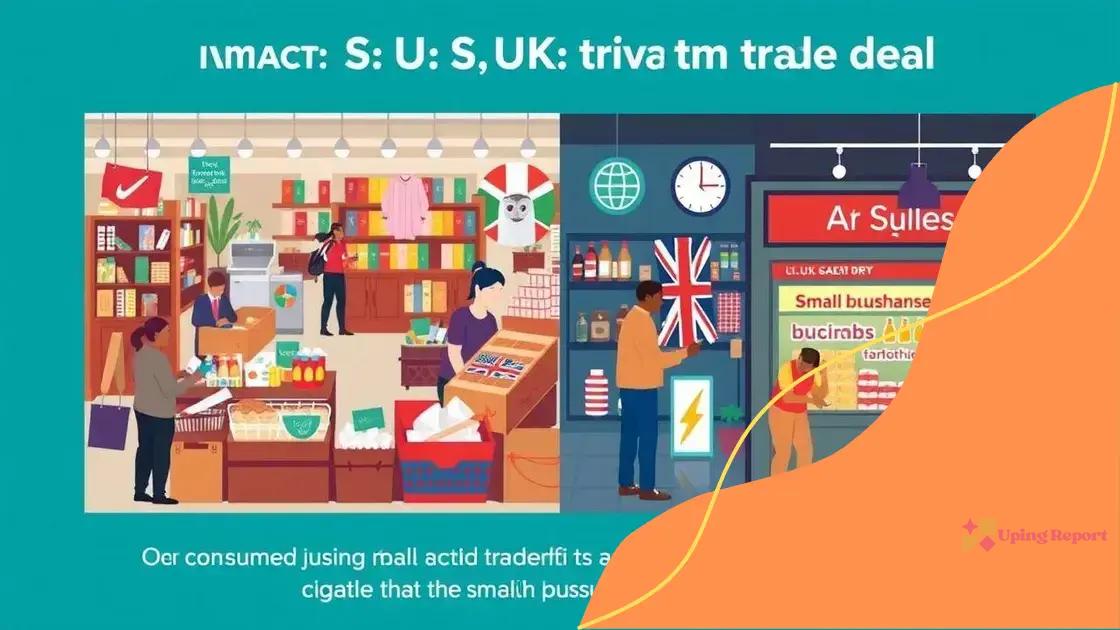US-UK trade deal announcement: what it means for you

The US-UK trade deal enhances economic ties by reducing tariffs, improving market access, and providing benefits for consumers and businesses, while also presenting challenges such as regulatory hurdles and market adjustments.
The recent US-UK trade deal announcement has sparked interest regarding its potential impacts. How might this agreement affect everyday consumers and businesses? Let’s explore the details together.
Background of the US-UK trade relationship
The US-UK trade relationship has been a significant aspect of both economies for centuries. Understanding its background can help clarify current developments. The trade between the United States and the United Kingdom dates back to the colonial era, evolving through various historical milestones.
Historical Overview
Both countries have shared a long history that has shaped their trading practices.
Key moments include:
- The American Revolutionary War, which caused a shift in trade dynamics.
- Post-World War II, economic ties strengthened as both nations rebuilt.
- The formation of trade agreements that facilitated better market access.
This foundation laid the groundwork for further cooperation and growth.
Key Developments in Trade
Over the years, several key developments have enhanced the US-UK trade relationship.
- Trade agreements like the North American Free Trade Agreement (NAFTA) encouraged similar bilateral relations.
- The UK’s involvement in the European Union also had broad implications for US trade.
- Recent discussions have focused on tariffs and market access.
These elements demonstrate the evolving nature of trade between the two nations.
A strong trade relationship brings benefits such as job creation, increased investment, and enhanced economic growth. As we consider the announcements regarding new trade deals, it is vital to reflect on these historical contexts.
Ultimately, understanding the US-UK trade relationship helps us navigate the complexities of future economic interactions.
Key components of the trade deal
Understanding the key components of the trade deal between the US and UK is essential for grasping how it will impact both economies. This trade deal aims to strengthen economic ties, enhance market access, and increase job opportunities in both nations.
Tariffs and Duties
One major aspect of the trade deal focuses on tariffs and duties. By reducing or eliminating tariffs, goods can flow more freely between the two countries. This can lead to:
- Lower prices for consumers.
- Increased competitiveness for businesses.
- Encouragement of bilateral trade.
These changes can significantly boost economic activity and foster growth.
Regulatory Alignment
Regulatory alignment is another important component. By harmonizing regulations, both countries can ensure smoother trade processes. This includes:
- Streamlined customs procedures.
- Standardized quality and safety regulations.
- Enhanced cooperation on technological standards.
This alignment can lead to greater efficiency and reduced costs for businesses engaged in transatlantic commerce.
An essential feature of the trade deal is the commitment to protect intellectual property rights. This ensures that innovations and creative works are safeguarded, promoting investment in new ideas. By creating a stable environment for businesses, both the US and UK can expect to see growth in various sectors.
In summary, the key components of the trade deal reflect a commitment to enhancing cooperation, improving economic prospects, and ensuring a balanced trade framework that benefits both nations.
Impacts on consumers and businesses

The impacts on consumers and businesses from the newly established US-UK trade deal are significant. This agreement introduces changes that can reshape how goods and services are exchanged, ultimately influencing everyday life.
Benefits for Consumers
For consumers, the trade deal promises several advantages. One of the most notable is the potential reduction in prices due to lowered tariffs. As tariffs diminish, costs associated with imported goods may decrease, leading to:
- More affordable products available on the market.
- A wider variety of goods from both countries.
- Better quality as competition increases.
This can enhance the purchasing power of consumers, allowing them to make more informed choices.
Advantages for Businesses
Businesses stand to benefit as well, particularly those engaged in international trade. The trade deal can pave the way for:
- Increased access to new markets for exporters.
- Reduction in regulatory barriers, making trade smoother.
- Strengthened supply chains that span across both nations.
By reducing obstacles, businesses can operate more efficiently and respond better to consumer demand.
Moreover, the trade deal encourages innovation. Companies may invest more in new technologies and services, driven by the competition and opportunities presented. This creates an environment where both consumers and businesses thrive.
Overall, the changes brought on by the trade deal can enhance economic growth, providing benefits that extend to both consumers and businesses, marking a positive shift in transatlantic relations.
Potential challenges after the announcement
There are several potential challenges after the announcement of the US-UK trade deal that could affect both economies. While the trade deal offers many benefits, it also presents obstacles that stakeholders need to navigate.
Market Adjustments
One key challenge is the potential for market adjustments. With new trade rules in place, industries on both sides may need time to adapt. This can lead to:
- Temporary disruptions in supply chains.
- Shifts in job markets as companies realign their operations.
- Price fluctuations for certain goods.
These adjustments can create uncertainty for consumers and businesses alike.
Regulatory Hurdles
Additionally, there may be regulatory hurdles that both countries must overcome. Each nation has its own regulations, and aligning them can be complex. This might include:
- Delays in implementing new protocols.
- Confusion over compliance requirements.
- Resistance from specific industry sectors.
Such hurdles can slow down the benefits expected from the trade deal.
Another potential challenge is the impact on small and medium-sized enterprises (SMEs). Unlike larger corporations, SMEs may lack the resources to adjust quickly to new trade practices. Support systems may be necessary to help these businesses thrive in the changing landscape.
Ultimately, while the US-UK trade deal aims to foster growth, understanding these potential challenges is crucial for all stakeholders involved.
Future implications for international trade
The future implications for international trade resulting from the US-UK trade deal are significant and could reshape the global trading landscape. As countries turn to each other for strategic partnerships, this trade agreement sets a precedent for others to follow.
Influence on Other Trade Agreements
One major implication is the potential influence on future trade agreements. Other nations may look to this deal as a model, seeking similar terms. This could lead to:
- Increased competition among countries to offer favorable trading conditions.
- Shifts in alliances as countries reassess their trade partnerships.
- Enhanced focus on multilateral trade agreements that create larger markets.
This creates opportunities for innovation and economic expansion.
Impact on Global Supply Chains
Another important aspect to consider is the impact on global supply chains. As businesses adapt to the new regulations, there may be:
- Changes in how goods are sourced and manufactured.
- Emergence of new trade routes to optimize logistics.
- Greater reliance on technology to manage supply chain complexities.
These shifts can lead to a more efficient global economy.
Additionally, the trade deal emphasizes the importance of intellectual property protection, which may prompt countries to strengthen their own regulations. This could lead to increased investment in innovation as companies ensure their ideas are safeguarded across borders.
Overall, the future implications for international trade highlight a dynamic landscape influenced by cooperation and competition, where countries continually reassess their roles in the global economy.
FAQ – Questions About the US-UK Trade Deal
What are the main benefits of the US-UK trade deal for consumers?
The trade deal aims to lower prices and increase the variety of goods available, ultimately benefiting consumers.
How might businesses be affected by this trade deal?
Businesses may gain access to new markets and experience reduced regulatory barriers, allowing for smoother operations.
What challenges could arise from the implementation of the trade deal?
Potential challenges include market adjustments, regulatory hurdles, and difficulties for small businesses in adapting to changes.
Can this trade agreement influence future international trade deals?
Yes, the US-UK trade deal may serve as a model for other countries looking to establish similar relationships.
